
The Pallava dynasty existed from 275 CE to 897 CE, ruling a significant portion of the Deccan, also known as Tondaimandalam. The Pallavas played a crucial role in shaping in particular southern Indian history and heritage. The dynasty rose to prominence after the downfall of the Satavahana Empire, whom they had formerly served as feudatories.

The Kadambas were an ancient royal family of Karnataka, India, that ruled northern Karnataka and the Konkan from Banavasi in present-day Uttara Kannada district. The kingdom was founded by Mayurasharma in c. 345, and at later times showed the potential of developing into imperial proportions. An indication of their imperial ambitions is provided by the titles and epithets assumed by its rulers, and the marital relations they kept with other kingdoms and empires, such as the Vakatakas and Guptas of northern India. Mayurasharma defeated the armies of the Pallavas of Kanchi possibly with the help of some native tribes and claimed sovereignty. The Kadamba power reached its peak during the rule of Kakusthavarma.

The Salankayana dynasty of ancient India ruled a part of Andhra region in India from 300 to 440 CE. Their territory was located between the Godavari and the Krishna rivers. Their capital was located at Vengi, modern Pedavegi near Eluru in West Godavari district of Andhra Pradesh.
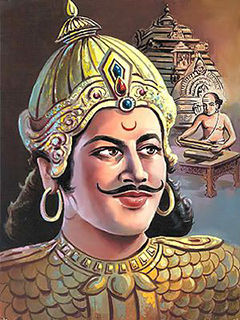
Mayurasharma or Mayuravarma, a native of Talagunda, was the founder of the Kadamba Kingdom of Banavasi, the earliest native kingdom to rule over what is today the modern state of Karnataka, India. Before the rise of the Kadambas, the centres of power ruling the land were outside the Karnataka region; thus the Kadambas' ascent to power as an independent geo-political entity, with Kannada, the language of the soil as a major regional language, is a landmark event in the history of modern Karnataka with Mayurasharma as an important historical figure. The earliest Kannada language inscriptions are attributed to the Kadambas of Banavasi.

Sadananda Sagar, better known by his stage name Vajramuni, was an Indian actor who appeared in Kannada films. He portrayed negative characters during most of his career and was considered one of Kannada cinema's finest actors. Over his career, he came to be known for his "thundering voice and sterling performance[s]" that earned him the epithets, Nata Bhairava and Nata Bhayankara.

The political history of medieval Karnataka spans the 4th to the 16th centuries in Karnataka region of India. Previously foreign empires held sway over the region, and the nucleus of power was outside modern Karnataka. The medieval era can be broadly divided into several periods: The earliest native kingdoms and imperialism; the successful domination of the Gangetic plains in northern India and rivalry with the empires of Tamilakam over the Vengi region; and the domination of the southern Deccan and consolidation against Muslim invasion. The origins of the rise of the Karnataka region as an independent power date back to the fourth-century birth of the Kadamba Dynasty of Banavasi, the earliest of the native rulers to conduct administration in the native language of Kannada in addition to the official Sanskrit. This is the historical starting point in studying the development of the region as an enduring geopolitical entity and of Kannada as an important regional language.
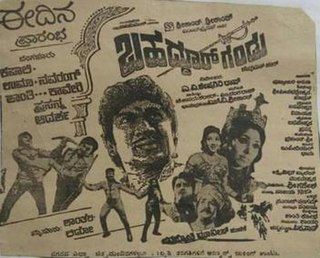
Bahaddur Gandu is a 1976 Indian Kannada-language swashbuckler film directed by A. V. Sheshagiri Rao, starring Rajkumar, Jayanthi, Aarathi and Vajramuni. The movie saw a theatrical run of 19 weeks. The story was penned by the celebrated playwright H. V. Subba Rao based on William Shakespeare's play The Taming of the Shrew.

Talagunda is a village in the Shikaripura taluk of Shivamogga district in the state of Karnataka, India. Many inscriptions found here have provided insights into the rise of the Kadamba Dynasty.
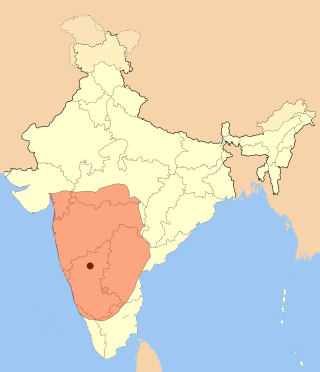
The Chalukya dynasty was a Classical Indian dynasty that ruled large parts of southern and central India between the 6th and the 12th centuries. During this period, they ruled as three related yet individual dynasties. The earliest dynasty, known as the "Badami Chalukyas", ruled from Vatapi from the middle of the 6th century. The Badami Chalukyas began to assert their independence at the decline of the Kadamba kingdom of Banavasi and rapidly rose to prominence during the reign of Pulakeshin II. After the death of Pulakeshin II, the Eastern Chalukyas became an independent kingdom in the eastern Deccan. They ruled from Vengi until about the 11th century. In the western Deccan, the rise of the Rashtrakutas in the middle of the 8th century eclipsed the Chalukyas of Badami before being revived by their descendants, the Western Chalukyas, in the late 10th century. These Western Chalukyas ruled from Kalyani until the end of the 12th century.

The Kadambas of Hangal was a South Indian dynasty during the Late Classical period on the Indian subcontinent, which originated in the region of Hangal in Karnataka. Chatta Deva who reigned from 980–1031 CE founded the dynasty. He helped Western Chalukyas in the coup against the Rashtrakutas; re-established the Kadamba Dynasty mostly as a feudatory of Western Chalukyas, but his successors enjoyed considerable independence and were almost sovereign rulers of Goa and Konkan till 14th century CE.

The Kadambas of Halasi was a South Indian dynasty during the Late Classical period on the Indian subcontinent, which originated in the region of Halasi, Karnataka; who were known for their own style of temple building. The Kadamba dynasty was founded by Mayurasharma in about 4th century AD. It was believed that Mayura was the first king of the dynasty and was the ruler during the time of Pallava King Vishnugopa of Kanchipuram. After losing to North Indian Emperor Samudragupta, Vishnugopa’s army had weakened. Mayura seized the opportunity, formed his own army and drove away the Pallavas from Kannada territory. On reaching Chandravalli, Mayura took shelter in a cave and founded his own dynasty. Banavasi, near Sirsi, was their first capital and their rule extended to Gomantak or present day Goa.

Odahuttidavaru (transl. Siblings) is a 1994 Indian Kannada-language romantic drama film directed by Dorai–Bhagavan and was jointly written by S. K Bhagavan and Chi. Udaya Shankar. The film stars veteran actors Rajkumar and Ambareesh in lead roles, along with Madhavi, Srishanti, Vajramuni and K. S. Ashwath in supporting roles. The film revolves around the two farmer brothers who undergo many traumas in their relationships due to external forces and fight them to reunite again.
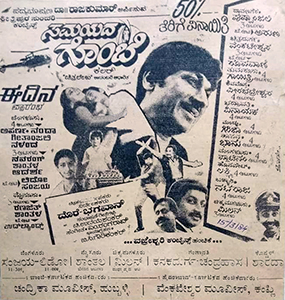
Samayada Gombe is a 1984 Indian Kannada-language drama film directed and co-produced by Dorai–Bhagavan. The film stars Dr. Rajkumar, Srinath, Roopa Devi and Menaka. It is based on the novel of same name written by Chitralekha. This is the first Kannada film of Malayalam cinema actress Menaka, who played the role of Rajkumar's sister and Srinath's wife in the film.
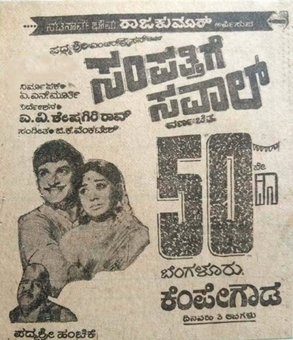
Sampathige Savaal is a 1974 Indian Kannada-language drama film directed by A. V. Seshagiri Rao and produced by A. N. Murthy, based on the play Saahukaara written by B. P. Dhuttharagi. The film stars Rajkumar, Vajramuni and Manjula. The screenplay, dialogues and lyrics for the soundtracks were written by Chi. Udaya Shankar.

Shankar Guru is a 1978 Indian Kannada-language action thriller film directed by V. Somashekhar, written by Chi. Udayashankar and produced by Parvathamma Rajkumar under the banner of Dakshayini Combines. It stars Rajkumar in the lead role alongside Jayamala, Padmapriya, Kanchana, Balakrishna, Vajramuni, Thoogudeepa Srinivas and Uma Shivakumar in supporting roles. Rajkumar appears in a triple role in the film — as a father and his two sons separated in childhood.
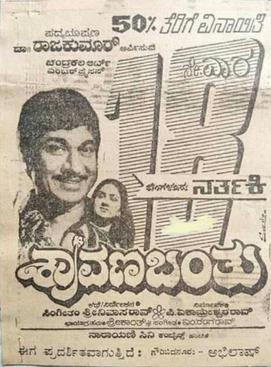
Shravana Banthu is a 1984 Indian Kannada-language romantic drama film, written and directed by Singeetham Srinivasa Rao. The film stars Rajkumar, Urvashi and Srinath. The film, produced by P. A. Kameshwara Rao, deals with reincarnation as the subject where the lead roles get killed for their romance and then they are shown to be reborn again and fall in love yet again in the backdrop of inter-faith marriage. The dialogues and lyrics were written by Chi. Udaya Shankar. The film was received exceptionally well at the box-office and was one of the biggest hits of 1984. This was the first Kannada movie to show a computer on-screen. The director remade the movie in the same year in Telugu as Vasantha Geetam.
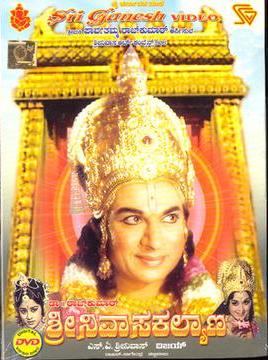
Sri Srinivasa Kalyana, is 1974 Kannada-language Hindu mythological film directed by Vijay. The film which is based on lord Venkateswara, stars Rajkumar, B. Saroja Devi and Manjula. It also featured the first screen appearances of future actors and Rajkumar's sons, Shiva Rajkumar and Raghavendra Rajkumar. The movie was dubbed in Tamil as Ezhumalaiyan Dharisanam and in Telugu as Sri Tirupatikshetra Mahatyam (1977).
Bidugade is a 1973 Indian Kannada language drama film directed by Y. R. Swamy and produced by T. P. Venugopal. It starred Rajkumar, Rajesh and Bharathi along with a host of supporting actors. Minugutare Kalpana made a special appearance in the film. M. Ranga Rao scored the music and the story was written and produced by Ramesh Movies. Chi. Udaya Shankar wrote the lyrics and dialogues. The cinematography by Annayya won him the Karnataka State Film Award for Best Cinematographer award.
Pattanakke Banda Pathniyaru is a 1980 Indian Kannada-language film, directed by A. V. Sheshagiri Rao and produced by S. D. Ankalagi, B. H. Chandannanawar, M. G. Hublikar and Surendra Ingle. The film stars Srinath, Manjula, Lokesh and Padmapriya. The film has musical score by M. Ranga Rao. The movie was remade in 1982 in Telugu as Patnam Vachina Pativrathalu. The song Shankara Gangadhara was retained in the Telugu version. The film was also remade in Tamil as Pattanamthaan Pogalaamadi (1990).

Raja Shankar or Rajashankar was an Indian actor in Kannada cinema. His films include Bhakta Kumbara (1974), Sampathige Saval (1974) and Sri Srinivasa Kalyana (1974). He also co-produced the 1974 Kannada movie Bangaarada Panjara starring Dr. Rajkumar and the 1976 Kannada movie Vijaya Vani.

















